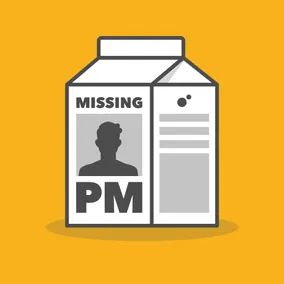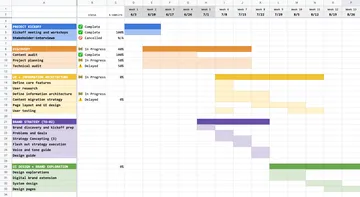On a Project Without a Project Manager? Here's What to Do.

Ryan Schaefer, Former Senior Project Manager
Article Categories:
Posted on
If you find yourself on a project without a Project Manager to handle client communication, planning, and drive the project forward, here's what you can do to make sure you establish an efficient process for success.
You and your organization may be familiar with this scenario: everyone is getting busier, there’s more work coming in and not enough people to staff it, yet everyone is committed to avoid burnout and not cutting corners when it comes to scoping and the execution of that work. What do you do?
Sometimes, that means turning work away if you can’t give it the attention it deserves. Other times, you need to reduce scope, which means changing team makeup and timeline to accommodate.
It’s not often that Project Managers are the ones who get pulled off a project in this scenario. It’s important to have someone dedicate time and thought to the management role—for lots of reasons.
When this does happen, though, perhaps in the case of certain staff augmentation projects or inflexible constraints dictated by RFPs, there are things other members of the team can (and should) do to keep a project running smoothly.
What to know before you put on your project manager hat.
Project Managers have a wide range of responsibilities. It can be difficult to conceptualize them all, so I’ve created this taxonomy that aims to capture the core facets of project management theory:

Just as projects vary in complexity, some of these tasks flex, sprout new responsibilities, or become less relevant.
This certainly doesn’t capture everything project managers do, though—and I won’t be talking about what that all entails. There are lots of resources out there to help you get the full picture. This article is about how any team member should approach managing a project when there isn’t a PM available.
If you’re facing a situation like this, you can think of these four main buckets (Client Services, Product Management, Cost & Time Management, and Leadership) as areas you’ll have to touch at some point throughout the project.
(One note on product management—it’s fairly common to have Product Managers and Project Managers as two distinct roles, each with separate areas of expertise. However, the responsibilities overlap in many cases, which is why product management isn’t meant to be a subset of project management, but rather, the tasks associated with it are things a Project Manager should be aware of, if not responsible for.)
So what do I do without my PM?
I’ve separated some critical project management tasks out below into three phases:
- What to do at the beginning of a project
- What to do throughout the project
- What to do near the end of a project
As you go through the project stages below, always keep in mind your overarching goals: client and team satisfaction, a smooth and transparent process, and a successful product.
Three key things to do at the start of a project.
1. Understand the client’s business objectives for the project.
The best way to do this is by asking questions. If there isn’t time for a formal kickoff where you lead a discussion around problems and goals, make a list of questions and send them to your main point of contact, asking them to filter it up to the relevant people if necessary. Then schedule a call to discuss it.
This is surprisingly transferable across projects. General topics like, “What do you hope to achieve with this?”, “Who is the audience your trying to reach?”, and “What are the frustrations with what you’re using now?” can help you gain insight into the client’s objectives and where you can contribute the most value.
The answers the client provides will create a shared understanding between everyone and help ensure you’re building the right thing.
2. Understand timeline and budget commitments.
Make time to huddle with your colleague who sold the project. They will be able to provide insight into important things like whether the established end date is a hard-and-fast rule, whether the budget is flexible if new requirements or feature requests arise, and anything else unique to this project. This will help you approach the project and conversations with the client appropriately.
3. Plot out a weekly schedule.
The more specific you can get here, the better. But there may not be time to get into the weeds. A high-level timeline like this doesn’t take very long to put together, and should work fine:

Try to keep it updated consistently. Documents like this often serve as the source of truth for PMs and facilitate how we prioritize all activities, slot in deliverables, and create touchpoints with the whole team and the client. That may not be necessary for you, but it will certainly provide a holistic snapshot of the project to the client.
Three key things to do throughout the project.
1. Make sure you know who the stakeholders are and that you’re getting in front of them.
This is something that can burn you. While it’s important to facilitate most things through your main point of contact, it’s a lot to ask of them to get approval from everyone who needs to be consulted, filter and transfer that feedback to you in an actionable way, and check against that during the next iteration. All this on top of everything else they’re doing, both on this project and their other work, can lead to things slipping through the cracks. Also consider that they may be more comfortable if you’re the one providing stakeholders with the appropriate context around decisions and logic they’re not as familiar with.
A RACI matrix is a good way to track stakeholder roles for all this, but that can take a lot of time and effort to maintain. In lieu of having one, you just need to be very mindful of who needs to sign off on what. Your client is aware of the executives who will have an opinion or need to be consulted. Encourage them to regularly get you in front of those people so they don’t have to manage that process by themselves.
2. Set up recurring meetings with your client.
I’ve found that chatting or meeting with your client at least once a week is necessary. Not only does it keep everyone on the same page and can be a forum to ask questions, but it also helps you build that relationship.
You can keep touchpoints informal, but keep the client aware of timeline, budget, blockers, work-to-date, and work on the near horizon. They should feel like they can answer any questions about the project if the CEO walks up to them and asks how things are going.
3. Keep an eye on your current progress vs. expected progress.
This is Project Management 101. If you’re missing the deadlines you’ve set, you’ll get yourself in trouble as you near the end of the project. The worst case scenario is you haven’t done any progress-tracking and you find yourself in a position where you have one week left of budget but four weeks of work. That’s not a pleasant conversation to have with a client.
Instead, if you have some milestones to guide you and can see immediately when you don’t achieve them, you can start making contingency plans. And if none are available, you can still be proactive about flagging the need for more time, budget, or reshuffling of priorities early with your client. I’ve found these conversations to be generally easier than you think—most people are appreciative that you’re keeping a close eye on this and are thankful you are giving them options.
Three key things to do near the end of a project.
1. Clearly convey that all agreed-upon requirements or objectives were met.
This is where that discussion you had way back at the beginning of the project about goals will come in handy. You’ve spent all this time making something awesome, and you can say with certainty that it works as expected (or better). That’s the easy part.
If you discover something you missed (which hopefully shouldn’t happen if you’ve been tracking things closely and regularly chatting with your client), see if you can prioritize it to fit within the remaining timeline. If not, that’s a conversation you need to have first with either your supervisor or the person who sold the project—they might have advice and insight into what you should do next. Either way, those conversations with clients get more difficult the longer you put them off.
2. Discuss what happens when the project ends.
It’s best to do this as soon as you feel confident about when you’ll wrap up. Sometimes, things can get a little murky while everyone is heads down on the work and it’s unclear who is owning things like code repositories, raw design files, Google Search console verification, testing that form submissions are functioning, or even launch.
We do formal launch plans if the project calls for the actual launch of an application or website, but even if it doesn’t, have a conversation with your client dedicated to hashing out those details. The more organized and thorough you are about this, the more likely things are to wrap up on a high note.
3. Don’t lose touch with your client.
If all went well, hopefully there’s a point where you and your client can work together again. Sometimes this happens right away, and sometimes it’s years down the road, through word of mouth from a friend of a friend.
It’s surprising how easy it is to overlook staying in touch with previous clients. I make events in my calendar to ping clients a couple months down the road and ask how they’re liking the work we did together. We also do post-launch metrics for sites we build and sometimes create a post-launch metrics report to send their way. Whatever is relevant to you, it’s always nice to check in, even just to chat.
Take a deep breath—you’ve done it.
In the end, the way you run the project cannot be successful without great UX, design, development, and more to back it up, just as great work cannot be successful without a solid plan to get there.
Don’t lose focus on your main responsibilities as a creative, developer, analyst, or other primary role, but also, don’t let PM duties fall to the wayside—in the end, staying on top of those will make your life much easier.
(By the way, if you are interested in working as a Project Manager at Viget, we’re hiring!)